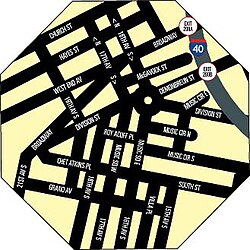Music Row
Music Row | |
|---|---|
District | |
 A map of the Music Row district in Nashville | |
| Coordinates:36°08′53″N86°47′35″W/ 36.148°N 86.793°W | |
| Country | United States |
| State | Tennessee |
| County | Davidson |
| City | Nashville |
| Time zone | UTC-6:00(CST) |
| • Summer (DST) | UTC-5:00(CDT) |
| Area code | 37212 |
Music Rowis a historic district located southwest of downtownNashville, Tennessee,United States. Widely considered the heart of Nashville'sentertainment industry,Music Row has also become ametonymousnickname for the music industry as a whole, particularly incountry music,gospel music,andcontemporary Christian music.
The district is centered on 16th and 17th Avenues South (called Music Square East and Music Square West, respectively, within the Music Row area), along with several side streets.[1]Lacy J. Daltonhad a hit song in the 1980s about16th Avenue,while the area served as namesake toDolly Parton's 1973 composition "Down on Music Row".In 1999, the song"Murder on Music Row"was released and gained fame when it was recorded byGeorge StraitandAlan Jackson,lamenting the rise of country pop and the accompanying decline of the traditional country music sound.[2][3]
The area hosts the offices of numerousrecord labels,publishing houses,music licensingfirms,recording studios,video productionhouses, along with other businesses that serve the music industry, as well asradio networks,andradio stations.MusicRowMagazinehas reported on the music industry since 1981.[4]
In present years, the district has been marked for extensive historical preservation and local as well as national movements to revive its rich and vibrant history. A group dedicated to this mission is theMusic Industry Coalition.[5][6][7]
History
[edit]In his 1970 bookThe Nashville Sound,Paul Hemphilldescribed Music Row as the area "where almost all of Nashville's music-related businesses operate out of a smorgasbord of renovated old single- and two-story houses and sleek new office buildings."[8]RCA Victor,Decca Records,andColumbia Recordseach completed at least 90 percent of country recordings at music Row.[9]Elsewhere, observed Hemphill, Music Row had "a montage of 'For Sale' signs [and] old houses done up with false fronts to look like office buildings."[9]
Throughout the 1960s, property values on Music Row grew, for instance a 50-foot lot from $15,000 in 1961 to $80,000 in 1966.[10]
Points of interest
[edit]Music Row includes historic sites such asRCA's famedStudio BandStudio A,where hundreds of notable and famous musicians have recorded.Country musicentertainersRoy AcuffandChet Atkinshave streets named in their honor within the area.[11][12]
TheCountry Music Association(CMA) opened its $750,000 headquarters in Music Row in 1967. Themodernistbuilding included CMA's executive offices and theCountry Music Hall of Fame and Museum.[9]Next door to the CMA headquarters isBroadcast Music Inc.[9]
The firstCountry Music Hall of Famesat at the corner of Music Square East and Division Street from April 1967 to December 2000, but the building has since been torn down and the museum moved to a state-of-the-art building 11 blocks away inDowntown Nashvillein May 2001.[13]
One area of Music Row, alongDemonbreunStreet, was once littered with down-market tourist attractions and vanity "museums" of various country music stars. These began to disappear in the late 1990s with the announced move of the Country Music Hall of Fame. The strip sat largely vacant for a few years but has been recently redeveloped with a number of upscale restaurants and bars serving the Downtown and Music Row areas.
At the confluence of Demonbreun Street, Division Street, 16th Avenue South, and Music Square East is the "Music RowRoundabout,"acircular intersectiondesigned to accommodate a continuous flow of traffic. Flanking the intersection to the west is Owen Bradley Park, a very small park dedicated to notablesongwriter,performer, and publisherOwen Bradley.Within the park is a life-size bronze statue of Bradley behind a piano. Inside the roundabout is a large statue called the "Musica".[14]
At the other end of Music Row, across Wedgewood Avenue sits theBelmont Universitycampus, andVanderbilt Universityis also adjacent to the area. Belmont is of particular note because of itsMike CurbCollege of Entertainment & Music Business (CEMB), part ofBelmont Universityand a major program in its commercial music performance division.
See also
[edit]References
[edit]- Sources
- Hemphill, Paul(1970).The Nashville Sound: Bright Lights and Country Music.New York: Simon & Schuster.ISBN0-671-20493-9.
- Notes
- ^"Music Row, Nashville".Tennessee Encyclopedia.March 1, 2018.RetrievedNovember 15,2018.
- ^“Murder On Music Row” and McCourys Rake In Bluegrass Hardware
- ^Alan Jackson gives Nashville the finger
- ^"David Ross, Founder of Music Row".This Week In Music.Ian Rogers. Archived fromthe originalon March 8, 2012.RetrievedAugust 30,2012.
- ^Rau, Nate (November 21, 2016)."Music Row preservation takes major step forward".The Tennessean.RetrievedNovember 15,2018.
- ^"Nashville's Music Row".National Trust for Historic Preservation.RetrievedNovember 15,2018.
- ^Sisson, Patrick (May 2, 2016)."To Honor Nashville's Music Row, Entire District Submitted for Historic Recognition".Curbed.com.RetrievedNovember 15,2018.
- ^Hemphill 1970,pp. 35–36.
- ^abcdHemphill 1970,p. 36.
- ^Hemphill 1970,p. 37.
- ^"RCA Studio B".National Register of Historic Places.National Park Service.RetrievedNovember 15,2018.
- ^Garrison, Joey (October 21, 2017)."Iconic signs at Nashville's historic Studio A return after nearly 50 years".The Tennessean.RetrievedNovember 15,2018.
- ^Thanki, Juli (March 24, 2017)."Country Music Hall of Fame and Museum celebrates 50 years".The Tennessean.RetrievedNovember 15,2018.
- ^Todd, Jen (February 25, 2016)."Music Row statue Musica to get fountains".The Tennessean.RetrievedNovember 15,2018.
Further reading
[edit]- How Nashville Became Music City, U.S.A.: 50 Years of Music Row(2006), Michael Kosser[1]
